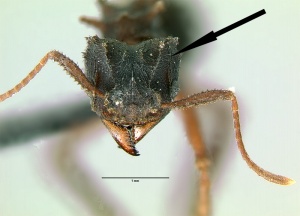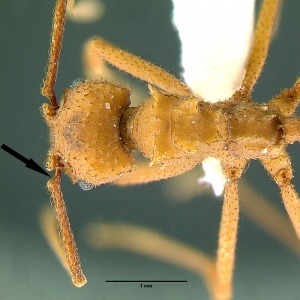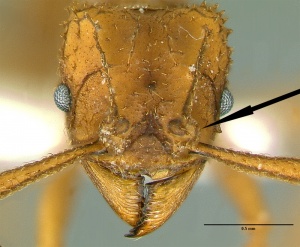Key to US Trachymyrmex
Key to the workers & queens of US Trachymyrmex species.
Based on: Rabeling, C., S. P. Cover, R. A. Johnson, and U. G. Mueller. 2007. A review of the North American species of the fungus-gardening ant genus Trachymyrmex (Hymenoptera : Formicidae). Zootaxa.1-53.
The Mexican species Trachymyrmex pakawa, described after this key was published, can be keyed out using a modified version of this key as noted at the end of the page.
1
a. In full-face view, preocular and frontal carinae subparallel, converging gradually towards the posterior corners of the head, forming a long, shallow antennal scrobe (click on the image below for a larger view of these characters) .......... => 2
b. In full-face view, preocular and frontal carinae NOT subparallel (click on the image below for a larger view of these characters), frontal carinae often extending towards the posterior corners of the head, but preocular carinae always curving mesially towards the frontal carinae, rarely actually touching them .......... => 3
2
a. In full-face view, antennal scapes reaching or just slightly surpassing the posterior corners of head. In side view, center of clypeus with several long, conspicuous, coarse, erect hairs, nearly as long as those in the row of long hairs along the anterior clypeal margin that project over the dorsal surface of the mandibles .......... => Mycetomoellerius turrifex
b. In full-face view, antennal scape surpassing posterior corner of head by the maximum diameter of the scape or more. In side view, clypeus usually with only a few short, stiff erect hairs present, when present these are much shorter than the row of long hairs along the anterior clypeal margin .......... => Mycetomoellerius jamaicensis
3
a. Frontal carinae relatively short, not extending towards the posterior corner of the head. Preocular carinae curving strongly to meet the frontal carinae, forming short, distinctive “scrobes”, that end slightly behind the level of the eye (Figure [10B]). Antennal scape long (SI 117–152), narrowing abruptly as it approaches the antennal insertion, a small but conspicuous lobe is present just distal to the narrowing (Figure [10C]) (Figures 10 & 11) .....=> Trachymyrmex nogalensis
b. Frontal carinae long, extending well past the eye towards the posterior corners of the head. In side view, preocular carinae not joining the frontal carinae (rarely touching the carinae in T. carinatus). Antennal scapes shorter (SI 113). Scape gradually narrowing as it approaches the antennal insertion, lobe as described above absent .......... => 4
4
a. In full-face view, frontal lobes prominent, shaped uniquely as in image just below, the posterior margin of the lobe forming a broad notch with the posterior portion of the frontal carinae. Antennal scapes long (worker SI 103–113; queen SI 96–105). First gastric tergite strongly tuberculate.......... => Trachymyrmex arizonensis
b. In full-face view, frontal lobes simple, rounded or triangular. Antennal scapes shorter (worker SI 105; queen SI 96). Gastric tubercles variously developed, sometimes small or nearly absent .......... => 5
5
a. Combining the following: in larger workers head clearly broader than long, slightly broader than long to square in smaller workers (CI 100–111); posterior border notably emarginate, in full-face view head appearing cordate in larger workers. Propodeal spines longer than the distance separating their bases. Color black to blackish red .......... => Trachymyrmex smithi
b. Head shape variable, usually more or less square, sometimes broader than long. Posterior border weakly to moderately emarginate, but head never appearing cordate in full-face view—even in larger workers (Figure [3B]). Propodeal spines or teeth variable in length, often as long as or shorter than the distance separating their bases. Color never black or blackish .......... => 6
6
a. Combining the following: median anterior pronotal tubercles well-developed, in anterior view nearly always upright and toothlike, the apices often with 2–3 small “peaks.” Preocular carina never closely approaching the frontal carina in full-face view. First gastric tergite tuberculate .......... => Trachymyrmex septentrionalis
b. Median anterior tubercles poorly developed or absent altogether, not upright or toothlike in anterior view, when present taking the form of small denticles or low, broadly pyramidal mounds. Preocular carinae variable, sometimes closely approaching the frontal carinae in full face view. Tuberculi on first gastric tergite sometimes absent or minute .......... => 7
7
a. Preocular carinae traversing nearly the entire antennal scrobe as it curves towards the frontal carina, closely approaching or sometimes even appearing to touch the frontal carinae in full-face view. Frontal lobes usually more or less symmetric (evenly rounded). First gastric tergite conspicuously tuberculate .......... => Trachymyrmex carinatus
b. Preocular carinae shorter, in full-face view never closely approaching or appearing to touch the frontal carinae in full-face view. Frontal lobes variable, sometimes asymmetric with the anterior margin longer than the posterior margin. Tubercules miniscule or absent on first gastric tergite .......... => 8
8
a. In full-face view, frontal lobes rounded (rarely subtriangular), more or less symmetrical, anterior and posterior sides equal in length or anterior side slightly longer than posterior .......... => Trachymyrmex desertorum
b. In full-face view, frontal lobes subtriangular (rarely rounded), strongly asymmetric, the anterior side of the lobe often 2x as long as the posterior side or more .......... => Trachymyrmex pomonae
The following modification of the key above allows for the identification of the species Trachymyrmex pakawa
3a
- Frontal carinae relatively short, not extending towards the posterior corner of the head. Preocular carinae curving strongly to meet the frontal carinae, forming short, distinctive depressions or “scrobes” that end slightly behind the level of the eye (figure [10B] in Rabeling et al. 2007). Antennal scape long (SI 117–152), narrowing abruptly as it approaches the antennal insertion, a small but conspicuous lobe is present just distal to the narrowing (figures 10 and 11 in Rabeling et al. 2007) . . . . . Trachymyrmex nogalensis
- Frontal carinae long, extending well past the eye towards the posterior corners of the head. In side view, preocular carinae not joining the frontal carinae (rarely touching the carinae in T. carinatus). Antennal scapes short (SI 84–89) or long (SI 94–113), not as long as in T. nogalensis. Scape gradually narrowing as it approaches the antennal insertion, lobe as described above absent (figures 1, 3, 5, 6, 12, 13, 15 and 17 in Rabeling et al. 2007) . . . . . 4
4a
return to couplet #3a
- Combining the following: In full-face view, frontal lobes prominent, shaped uniquely as in figure 1B in Rabeling et al. 2007; the posterior margin of the lobe forming a broad notch where it meets the frontal carinae. Antennal scapes long (worker SI 103–113; queen SI 96–105). Propodeal spines shorter than the distance separating their bases. First gastric tergite strongly tuberculate (figure 1 in Rabeling et al. 2007) . . . . . Trachymyrmex arizonensis
- In full-face view, frontal lobes simple, not shaped as above, but rounded or triangular (figure 3B in Rabeling et al. 2007). Antennal scapes short (worker SI 84–89 (105 in Rabeling et al. 2007) or long (SI> 93). Propodeal spines longer or shorter than the distance separating their bases. Gastric tubercles variously developed, sometimes small or nearly absent . . . . . 5
5a
return to couplet #4a
- Relatively large species (HW 1.0–1.38). In larger workers, head square or clearly broader than long, square or slightly broader than long in smaller workers; in full-face view head often appearing cordate in larger workers (figure 17B in Rabeling et al. 2007); antennal scape short, (SI 84–89) or long (SI 93.5 - 109.5). Propodeal spines longer than the distance separating their bases. Color dark reddish brown, fuscous or black (figure 17 in Rabeling et al. 2007); from typical flat, open Chihuahuan desert habitats, or rocky habitats of the northern Sierra Madre Oriental . . . . . 6
- Smaller species (HW 0.78–1.12). Head shape variable, usually more or less square, sometimes broader than long. Posterior border weakly to moderately emarginate, but head never appearing cordate in full-face view—even in larger workers (figure [3B] in Rabeling et al. 2007). Propodeal spines variable in length, often as long as or shorter than the distance separating their bases. Color never black, usually not dark reddish brown, commonly brownish yellow to medium reddish-brown . . . . . 7
6a
return to couplet #5a
- Combining the following: in larger workers head clearly broader than long, slightly broader than long to square in smaller workers; antennal scape short, SI 84–89; in full-face view head appearing cordate in larger workers (figure 17B in Rabeling et al. 2007). Color black to blackish red (figure 17 in Rabeling et al. 2007); from typical flat, open Chihuahuan desert habitats, usually on sandy soil ) . . . . . Trachymyrmex smithi
- Similar to T. smithi but antennal scapes clearly longer (this work), SI 93.5–109.5; head not as clearly cordate, nor broader than long; color dark reddish brown (Figure 2, this work) or rarely light ferruginous red, not blackish; from warm-temperate forest and scrubland habitats at the northern Sierra Madre Oriental of Mexico (Gran Sierra Plegada mountains near Monterrey, Saltillo and Iturbide). Nests usually on steep terrain, slopes and near cliffs, on very rocky (not sandy) soils . . . . . Trachymyrmex pakawa












